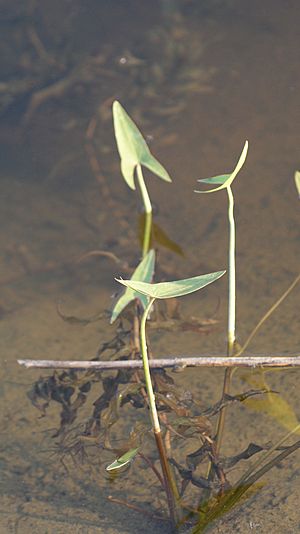Arumleaf arrowhead facts for kids
Quick facts for kids Arumleaf arrowhead |
|
|---|---|
 |
|
| Scientific classification | |
| Genus: |
Sagittaria
|
| Species: |
cuneata
|
| Synonyms | |
|
|
Sagittaria cuneata is a flowering plant known by common names like arumleaf arrowhead or duck potato. It is part of the water plantain family. Sometimes, like other Sagittaria plants, it is also called wapato. This plant grows naturally across much of North America. You can find it in most of Canada and many parts of the western and northeastern United States. This includes Alaska but not Hawaii.
Contents
About the Arumleaf Arrowhead
Sagittaria cuneata is an aquatic plant, which means it grows in water. It likes slow-moving or still water, such as in ponds and small streams. This plant can look quite different depending on where its parts are growing. Parts underwater look different from those growing above the surface or on land.
It is a perennial herb, meaning it lives for more than two years. It grows from a tuber, which is like a swollen underground stem. This tuber is usually white or has a blue tint.
Leaves and Flowers
The leaves of the arumleaf arrowhead can vary in shape. Many of them are sagittate, which means they are shaped like an arrow. They have two smaller, pointed parts that stick out opposite the main tip. These leaf blades grow on very long petioles, which are like leaf stalks.
This plant is monoecious. This means that each individual plant has both male and female flowers. The flowers grow on a stalk called an inflorescence that rises above the water. This stalk is a raceme, which means the flowers are arranged along a central stem.
The flowers are grouped in several circles, called whorls. The lowest whorls on the stalk have female flowers. The whorls higher up on the stalk have male flowers. Each flower can be up to 2.5 centimeters wide and has white petals. The male flowers have rings of yellow stamens in their centers. The female flowers have a round cluster of pistils. These pistils later develop into many tiny fruits.
Conservation Status in the United States
It is important to protect Sagittaria cuneata in some areas. This plant is listed as endangered in Connecticut and New Jersey. This means it is at high risk of disappearing from these states. It is also listed as threatened in Massachusetts, New Hampshire, and Ohio. This means it could become endangered in these states if not protected.
How Native Americans Used This Plant
Many Native American tribes have traditionally used the arumleaf arrowhead. This is part of their ethnobotany, which is the study of how people use plants.
- The Cheyenne people gave dried leaves to horses. This was to help with urinary problems and sore mouths.
- The Klamath tribe used the rootstocks of the plant as a food source.
- The Menominee tribe would dry, boil, and slice the potatoes (tubers). They would then string them together to store for winter.
- The Ojibwe people ate the corms (another type of underground stem) for indigestion. They also ate them as food. They would boil them fresh, dry them, or candy them with maple sugar.
- Animals like muskrats and beavers also gather these tubers. They store them in large hidden piles. Native Americans learned to find and use these animal caches.
- The Northern Paiute tribe used the roots for food.
- Indigenous people in Montana ate the tubers both raw and boiled.

